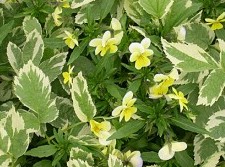 For a spring combination that will brighten the wakening garden try growing yellow and white Johnny Jump Ups. Plant the Johnnies in the fall after the bishop’s weed has succumbed to frost, enjoy them all winter, and then enjoy the bishop’s weed as it emerges in the spring with its creamy white edges. In warm climates the Johnnies will fade by the beginning of summer but the colorful leaves of the bishop’s weed will last well into fall. It will even bloom with white Queen Anne ’s lace type of flower heads but the real value of the plant is the foliage. Beware, however, the bishop’s weed can become invasive if it likes its location; part sun to part shade and plenty of moisture.
For a spring combination that will brighten the wakening garden try growing yellow and white Johnny Jump Ups. Plant the Johnnies in the fall after the bishop’s weed has succumbed to frost, enjoy them all winter, and then enjoy the bishop’s weed as it emerges in the spring with its creamy white edges. In warm climates the Johnnies will fade by the beginning of summer but the colorful leaves of the bishop’s weed will last well into fall. It will even bloom with white Queen Anne ’s lace type of flower heads but the real value of the plant is the foliage. Beware, however, the bishop’s weed can become invasive if it likes its location; part sun to part shade and plenty of moisture.
 Bishop’s Weed (Aegopodium podagraria ‘Variegatum’)
Bishop’s Weed (Aegopodium podagraria ‘Variegatum’)
A nice low growing ground cover, bishop’s weed is attractive, deer resistant, and very vigorous. It will spread over an area quickly crowding out any weeds that might consider growing with it, but does not penetrate lawns. It tolerates poor soil and is drought resistant once established.
-
Bloom Time: Early summer
Size: 12-24” H x 12-48” Width
Hardiness; Zones 3-9
 Viola cornuta ‘Penny Primrose’ (or any pale yellow viola)
Viola cornuta ‘Penny Primrose’ (or any pale yellow viola) Violas are small versions of the popular pansy but stand up against wind, rain, and cold better than their larger cousins. Like pansies, they can be planted in the fall and will continue to bloom during warm spells all through the winter and into the summer. They like a good dose of fertilizer in mid-winter but other than that will brighten your garden without fuss. Anything so pretty, fragrant, and hardy is bound to be popular with wildlife, right? Deer love them.
Violas are small versions of the popular pansy but stand up against wind, rain, and cold better than their larger cousins. Like pansies, they can be planted in the fall and will continue to bloom during warm spells all through the winter and into the summer. They like a good dose of fertilizer in mid-winter but other than that will brighten your garden without fuss. Anything so pretty, fragrant, and hardy is bound to be popular with wildlife, right? Deer love them.
-
Bloom Time: Fall to early summer (hot weather)
Size: 10”H x 10” W
Hardiness: Annual.
